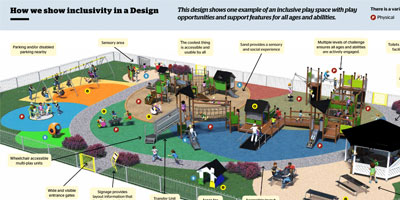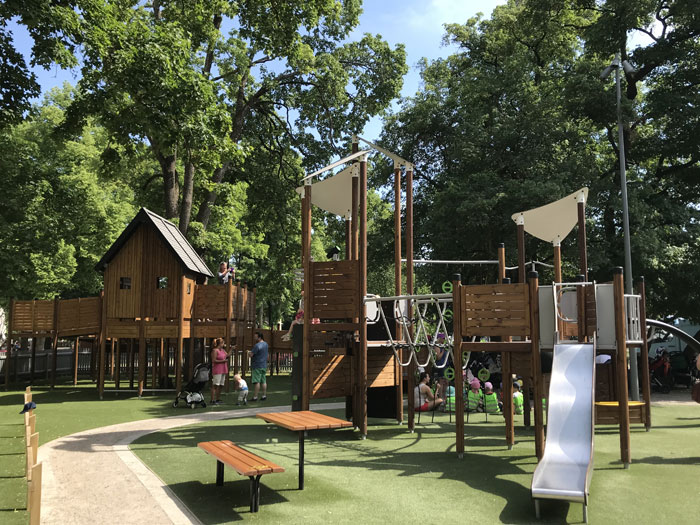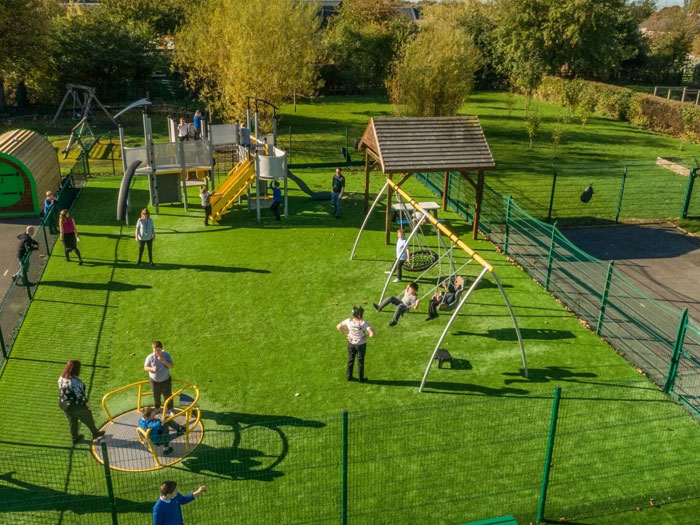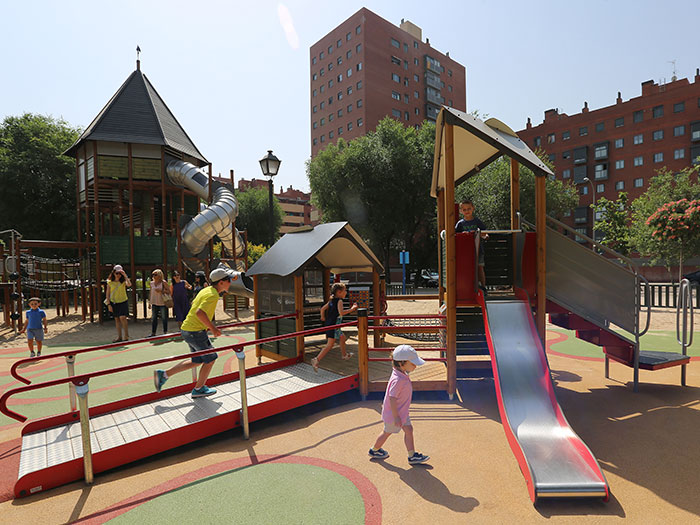Fill your basket with products by clicking "Add to my collection" from any product page. This can be found either within the product options panel or below the product image. Collections can be saved, and stored, within your HAGS Connect account or create and print your own custom brochure, download the files you need in one go, or to request a quote.
How supportive infrastructure help make your play space inclusive
Providing supportive infrastructure and amenities are other elements that makes your play space inclusive, safe and easy to use by people of all abilities.
To help make everyone’s visit enjoyable, it’s important to look at the support system and the built environment surrounding the play space, such as:
- Providing toilets and changing facilities
- Having a variety of seats
- Providing picnic tables and litter bins
- Incorporating cooling facilities, such as water fountains
- Having appropriate transport facilities
- Providing suitable signage
- Allowing children and parents to understand the layout, play equipment, and overall play space before leaving their house
- Permitting service and assistance animals to enter the play space
- Providing emergency call boxes

Provide toilets and changing facilities
Suitable toilet and changing facilities allow children and adults to visit the play space for longer and enjoy their visit with dignity and comfort.
Consider the scale and location of the play space when deciding what facilities are possible to include or access. Do not underestimate the importance of toilet and changing facilities to the success of an inclusive play space, make the provision of toilets and changing facilities a specific target in your project plans.
Improve routes and paths to and from existing facilities and put funds towards upgrading those facilities, if required. Make sure that you provide information about the facilities and have appropriate signage throughout the play space.
Changing Places toilets
Consider including a Changing Places toilet in your plans. These toilets are different to standard accessible toilets and if possible should be provided in addition to accessible toilets, this is because standard accessible toilets do not meet the needs of everyone.
People with profound and multiple learning disabilities, as well as people with other physical disabilities, often need extra equipment and space to allow them to use the toilets safely and comfortably. These needs are met by Changing Places toilets.

Have a variety of seats
Providing different types of seats allows parents, carers and children of all abilities to rest in proximity to one another and to the play space.
Position the seating to get the best vantage point to help parents and carers supervise children during play.
Seats should generally be closer to the play areas where younger children will play and a little further back for older children. Locate seating in an area where the user is protected from wind and can sit comfortably in all seasons.
Consider including play equipment and features that can also be used for caregivers to sit on.
Include benches with and without arm rests to allow someone in a wheelchair to transfer to them. Similarly, make sure that there is enough space for a wheelchair to be placed next to a bench.

Provide picnic tables and litter bins
Picnic tables
Picnic tables are great for people to eat, socialise and feel included in the activities. If possible, it's always ideal to have accessible picnic tables which have open spaces for wheelchairs that are looking out in different directions.
Leaving space for more than one wheelchair offers the chance for more people who use wheelchairs to sit comfortably together, as well as offering a choice of where each person can sit. If providing child-sized picnic tables, make sure to include wheelchair places on them as well.
The position of wheelchair spaces is key, for example, a space in the middle of the table places a person who uses a wheelchair closer to their friends and family increasing social interactions rather than always having to sit at the end of the table. In addition, for a parent with more than one child, a seat in the middle of the table enables the parent to care for children by sitting between them.
Provide seating and tables in each area that accommodates a wide range of statures, mobility levels and perceptual abilities and leave enough surface area around the tables for easier manoeuvring around the space. Don’t forget to allow for extra space and knee clearance.
Litter bins
Bins should be positioned on accessible routes and should not be placed within eating areas, instead they should be installed at the exits of each area.
Litter bins need to be suitable for everyone and people should be able to use them with only one hand, for example, open tops, slots, and push doors.
Bear in mind that spaces next to benches may be needed for people using wheelchairs to be close to people on the bench, therefore, do not locate bins in clear spaces next to benches.

Cooling facilities
Drinking fountains and cooling devices
Install at least two fountains at different heights to allow everyone at the play space to drink water while they are there and provide a facility for filling up their personal water bottles.
Provide drinking fountains that can be operated by a lever rather than a button.
For the summer months, include water features that are usable by all children and adults, such as water misters, water spray pads, etc. Make sure not to put them on a play structure as it can create a risk of slipping.
Shade
Adults and children with sun allergies and those susceptible to sun burn are often not able to go to standard play spaces where shade is not provided. Therefore, it’s important to provide spaces within the play space where users are not in direct sunlight.
There are various ways you can provide shade in your playground:
- Use established trees for shade
- Use one of our freestanding fabric shade structures
- Utilise fabric structures or roofs on top of the equipment as featured in some of our UniMinis and UniPlays
- Consider shading some of the seating or gathering areas, perhaps by using gazebos and pavilions
Do keep in mind that shade provided by a new tree will be very different than that provided by that same tree in 10+ years.

Transport facilities
Parking
Providing parking spaces for those who need their vehicle to be close to the equipment or features as well as a safe car park gives more people the opportunity to visit and use the play area.
Provide accessible parking spaces close to the play area, however, this does not mean that the whole parking area needs to be located nearby. For site design or aesthetic reasons, the accessible parking spaces may need to be separated from and be closer to the play space than the rest of the parking area.
Installing seats in the designated pick up/drop off points and waiting areas provides everyone who visits the play space with a more comfortable experience.
Provide a safe car park by separating vehicular travel routes from pedestrian routes and having the pedestrian routes and islands protected, for example, landscaped area with a sidewalk. Furthermore, separate areas should be created for different transportation modes, e.g. cars, bicycles, etc.
Alternative transportation
Allow people who cannot drive or do not have a car to use the play space. This can be done by placing transit stops separate from other vehicular loading and unloading zones in front of the play space entrance. You can also provide a protected area (from weather and other obstacles) that accommodates at least one personal wheeled mobility aid.
Think about installing bike racks near the primary entrance for people who wish to cycle to the play space and consider adding an area immediately inside the entry way where people can park their prams, buggies, wheelchairs and other adaptive equipment such as canes or walkers.

Providing signage
Signage visibility
Having alternatives to text available on signage allows everyone to understand the information, for example, audible and/or tactile modes, volume adjustment provided for audible displays, device triggers audible information by proximity, etc.
Contrast, font size, clarity, reading speed and height of main text should also be taken into account as well as ensuring surfaces are free from glare from the expected viewing location so that it is comfortable and easy to read for everyone.
Public statement of inclusive play
Educate the public about inclusion at a local level and make a clear statement to the community about the goals of the play space by installing a sign at the entrance of the park which explains the purpose of your inclusive play space.
Use positive images which give the message that ‘everyone is welcome’ and install an audio button that can be pushed to hear the information about the play space.

Introduction to the playground
For many disabled people, a significant amount of effort is required to get out of their house. For a trip to be enjoyable, information about access, public transport, layout of space, activities and accessible facilities needs to be provided ahead of time.
Create a website and other marketing material for the play space where you can provide information such as:
- A brief description of the play space and major features
- Directions to reach the play space, including public transport
- Whether the play space is fenced
- Whether the play space has accessible features such as toilets and picnic tables
Orientation materials can also be offered to prepare a child for their visit, for example, a video, a virtual map, a printable map, etc.
Printable symbols or picture cards can even be developed so that a child can point to where they want to go. These will also enable parents or carers to create story boards for children to prepare them for their visit.

Additional support features
Allow service and assistance animals
It is very important to allow children and adults who have a service or assistance animal to use the play space.
Make sure appropriate waste disposal is provided for dog waste and include signs that strongly encourage owners to dispose of dog waste responsibly.
Provide a water trough or basin for pets and service and assistance animals to use.
Emergency services
Enable the people at the play space to reach emergency services by including emergency call boxes and ensuring they are clearly marked and usable by someone using a wheelchair.
Keep in mind that not everyone has a mobile phone, and if they did, in the event of a parent becoming ill, the child may not know how to find the phone or use it.

Inclusive Pirate Themed Playground, Burgos, Spain
HAGS designed and developed an inclusive playground in the city of Burgos for children of all abilities to enjoy, creating a comfortable play area for both children and parents.
Read MoreInclusive Tree House Themed Playground, Sweden
A fantastic inclusive playground in the city of Uppsala, Sweden, featuring a tree house-themed customised UniPlay unit.
Read MoreSpecial Educational Needs School, UK
Kingsland Primary School is an outstanding rated Special Educational Needs school in Yorkshire, UK, which caters for children with a range of learning disabilities. They asked HAGS to design and build inclusive play areas for each of their two sites.
Read MoreInclusive Playground in Madrid, Spain
This new playground in the neighbourhood of Orcasitas in Madrid was initiated by the Government Department of Environment and Mobility who wanted a unique play area that was inclusive and accessible
Read More
HAGS Aneby AB
Grännavägen 7 578 33 Aneby
Contact Us
If you have questions or would like to know something about our products, you can contact us by phone, fax, email or directly on our website. If you do not know who at HAGS you should talk to, or if you would like to come in contact with a specific person at HAGS, you are welcome to call our switchboard to get connected to the right person.





.jpg)







































































Follow HAGS: